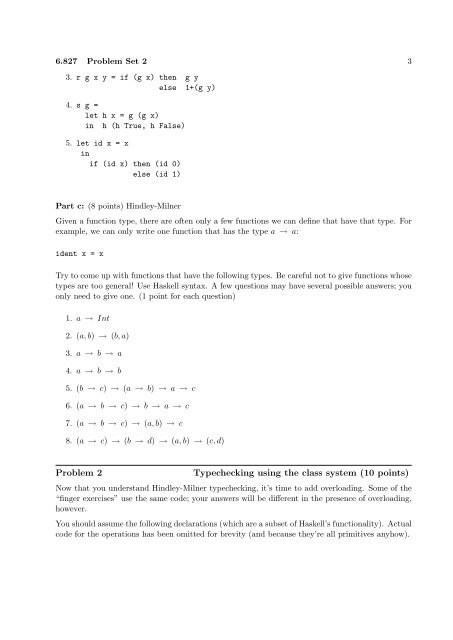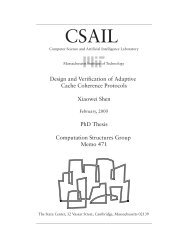Problem Set 2 - MIT
Problem Set 2 - MIT
Problem Set 2 - MIT
You also want an ePaper? Increase the reach of your titles
YUMPU automatically turns print PDFs into web optimized ePapers that Google loves.
6.827 <strong>Problem</strong> <strong>Set</strong> 2 3<br />
3. r g x y = if (g x) then g y<br />
else 1+(g y)<br />
4. s g =<br />
let h x = g (g x)<br />
in h (h True, h False)<br />
5. let id x = x<br />
in<br />
if (id x) then (id 0)<br />
else (id 1)<br />
Part c: (8 points) Hindley-Milner<br />
Given a function type, there are often only a few functions we can define that have that type. For<br />
example, we can only write one function that has the type a → a:<br />
ident x = x<br />
Try to come up with functions that have the following types. Be careful not to give functions whose<br />
types are too general! Use Haskell syntax. A few questions may have several possible answers; you<br />
only need to give one. (1 point for each question)<br />
1. a → Int<br />
2. (a, b) → (b, a)<br />
3. a → b → a<br />
4. a → b → b<br />
5. (b → c) → (a → b) → a → c<br />
6. (a → b → c) → b → a → c<br />
7. (a → b → c) → (a, b) → c<br />
8. (a → c) → (b → d) → (a, b) → (c, d)<br />
<strong>Problem</strong> 2 Typechecking using the class system (10 points)<br />
Now that you understand Hindley-Milner typechecking, it’s time to add overloading. Some of the<br />
“finger exercises” use the same code; your answers will be different in the presence of overloading,<br />
however.<br />
You should assume the following declarations (which are a subset of Haskell’s functionality). Actual<br />
code for the operations has been omitted for brevity (and because they’re all primitives anyhow).
















